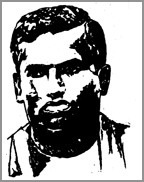|
Multifaceted communicatorWriting: Nobody says the large number of books written by the multifaceted writer Munidasa Cumaratunga [1887.07.25 to 1944.03.02] are unreadable as they are not written by a Pundit to another Pundit, whereas they are observable as written by a Pundit to suit readers of all ages ranging from the kid to the most erudite scholar. His range of activities included poems, stories, legends, children's stories, editorials and features appearing in three periodicals namely Pahana, Subasa, Lakmini Pahana, and the English journal titled Helios.
As a teacher well-versed in the languages of Sinhala, Pali, Sanskrit and English, he outshined as one of the most independent-minded saviours of the Sinhala literature, culture and the nation, from the imitative bonds of adverse types of influences that fast moved into the conscience of the country at a time when there was a clamour for the national identity of all groups, such as teachers, workers, physicians, social reformers, and communicators. As the numerous editorials and other contributions by Cumaratunga indicate, he had taken the standpoint of the independent clear minded intellectual, who clarified the issues enabling the opinion leaders to re-gauge their stance as regards decisions pertaining to such areas as education, religion, language, literature, culture, administration, politics, health and social reforms. He left no stone unturned in this venture, and investigated to the brim, perhaps making more foes than friends, in his outspokenness and literary tirades. TeachingHis teaching commenced with the writing of text books, such as Shiksa Margaya and Kiyavana Nuvana, wherein he introduced a new way of helping the student-teacher link in the classroom to venture forth into deeper waters in classics and grammar. Into the pages of these texts, he included his own original writings, full of national creative flavour, blended with the influence, he derived from the history, folklore, and religious sources. As a poet, he excelled in the creation of simple poems on nature such as Darunalavilla for children and thence culminating to heights of poetic creations like piyasamara, a poetic profile of his own father, which was not intended to be published. He was also a translator of poems from English to Sinhala, wherein one example could be cited, as one of the brilliant pieces that had entered the Sinhala poetic canons. This is a free though sincere version of "The elegy written in the country church yard" by Thomas Gray. "Full many a gem of purest ray serene The dark unfathomed caves of ocean bear Full many a flower is born to blush unseen And waste its sweetness on the desert air." These four lines are translated into Sinhala, retaining the original poetic tone, and the prophetic experience as follows: "Boho ruvan nimalmakan pahan Sadai guha agada sagare Boho kusum noka nuvan mahan Pavanhi palu mirala mare." MythsIt is also observed, he was a writer of old and modern myths and legends, most of which he compiled on his anthology of creative works titled Prabandha Sangrahaya. The folklore lover, and the deconstructionist to historical episodes is sensitively observed in some of the myths and legends, he recounts in this compilation. The story titled "Pol lada heti" or "how we got coconut" is one such example. He was an intellectual, who visualised, the proper flawless use of language enables one to think clearer and more creatively. Thus he exhibited in his poetic creations that the simplest poetic experiences with the simplest use of language results in the production of a creative work, more powerful than the same process via erudite rhetorical usages. The 'newness' in the creation he branded as 'alut alut de', and expounded the theory that if a nation is devoid of the freshness in creativity, that particular nation is doomed to disaster, and in the end to begging and death. This was a guiding principle he adhered to in his career as a journalist, which was the mainstay in his endeavour. On closer scrutiny of his various contributions, mainly the editorials to Lakmini Pahana, one sees the penetrative vision he possessed that catches the panoramic circle of enquiry into all aspects of culture, religion, language, politics, administration, and above all the independent thinking process. In one of his editorials he abhorred the English term 'vernacular', as used in the context of the local Sinhala teacher, and the Tamil teacher, for as shown by him the etymology of the term 'verna' means in Latin 'low' or to use his own Sinhala term 'nicha', which invariably is a derogative term for a teacher of an esteemed profession, and the teacher's calibre, according to him, becomes a 'nicha guru', or a low graded teacher. Sinhala termsAs far as possible he introduced quite a number of simple Sinhala terms now in use. For his credit as a media user, some of the terms are as follows: Sarasaviya for university, Sadiyan for voters, Preranava for motion, Pramana Patraya for certificate, Livisariya for literature, Veluma for volume, Katikava for discussion or discourse, Samuluva for seminar, Vada Muluva for workshop, and Hasuna for message. Some of these terms have come over the years through word of mouth, and now being used freely by scholars, as glossarial terms, as applicable for various subjects. Cumaratunga Munidasa left no significant Sinhala classical work untouched without his own imprint on the editing, and commentarial aspects, and one of the most significant contributions is the Tisara Sandesa Dipaniya [the commentary on the Tisara Sandesaya], where even the present-day scholar will undoubtedly find some of the finest insights into the age-old classical poetic usages and allusions. A collection of the editorial drawn from the Lakmini Pahana was launched by Visidunu Publishers on July 25 at the Colombo Museum auditorium to mark his 119th birth anniversary. |
|
.................................. |









